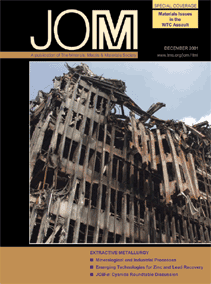 |
NEWS & UPDATE
|
|---|
 |
NEWS & UPDATE
|
|---|
|
|
|
|---|---|
 |
OTHER ARTICLES IN THE WTC
SERIES
Why Did the World Trade Center Collapse? Science, Engineering, and Speculation by Thomas Eagar and Christopher Musso Better Materials Can Reduce the Threat from Terrorism by Toni G. Maréchaux An Initial Microstructural Analysis of A36 Steel from WTC Building 7 by J.R. Barnett, R.R. Biederman, and R.D. Sisson, Jr. |
|
|
|
The World Trade Center towers were not the first of New York’s skyscrapers
to be hit by an airplane. In 1945, the Empire State Building withstood the
impact of a U.S. Army Air Corps B-25 bomber. Fourteen lives were lost, but
the steel structure remained standing after the unarmed trainer plane slammed
into the building’s 79th floor. The accident was ruled by authorities
to be caused by pilot error, after Lieutenant Colonel William F. Smith Jr.,
a decorated veteran of World War II and experienced pilot, apparently lost
his way in the dense fog that had enveloped Manhattan that Saturday morning
in July. Smith was flying the twin-engine bomber from his home in Bedford,
Massachusetts to Newark, New Jersey, where he had planned to pick up his commanding
officer before continuing on to home base in South Dakota. Smith had been
scheduled to land at La Guardia Airport, and the air traffic controller directed
him to do so. Smith, however, asked for and received permission to land in
Newark instead. The last words the air traffic controller spoke to Smith were
‘At the present time, I can’t see the top of the Empire State Building,’
according to the Empire State Building’s web site.
At 9:40 a.m., as workers went about their business in the Catholic War Relief
Office on the 79th floor, the B-25 crashed into that office at 322 kilometers
per hour. The impact reportedly tore off the bomber’s wings, leaving
a five meter by six meter hole in the building. One engine was catapulted
through the Empire State Building, emerging on the opposite side and crashing
through the roof of a neighboring building. The second engine and part of
the bomber’s landing gear fell through an elevator shaft. When the plane
hit, its fuel tanks were reported to have exploded, engulfing the 79th floor
in flames.
The 102-story building shook with the initial impact, according to witnesses,
but within three months, the damage was repaired at a cost of about $1 million.
Smith died in the crash, along with two other crew members. Eleven workers
died in the Catholic War Relief Office, and at least two dozen people were
injured.
Direct questions about this or any other JOM page to jom@tms.org.
| If you would like to comment on the December 2001 issue of JOM, simply complete the JOM on-line critique form | |||||
|---|---|---|---|---|---|
| Search | TMS Document Center | Subscriptions | Other Hypertext Articles | JOM | TMS OnLine |